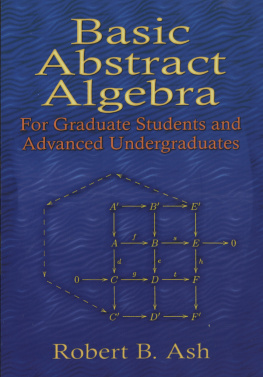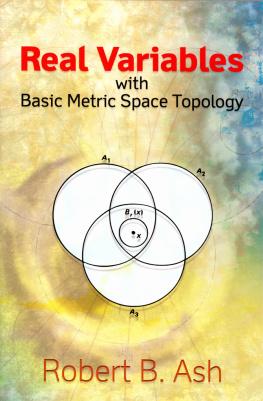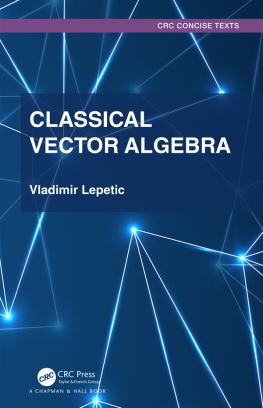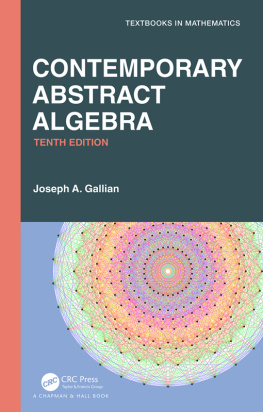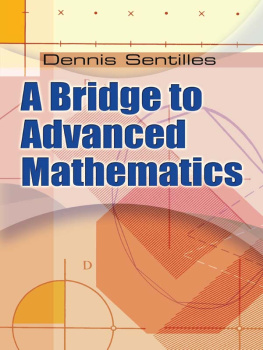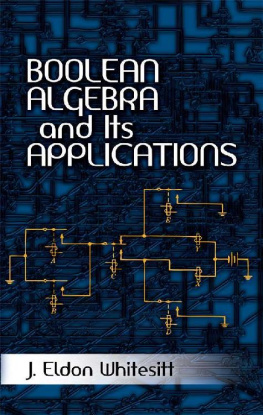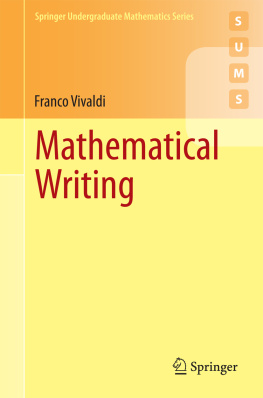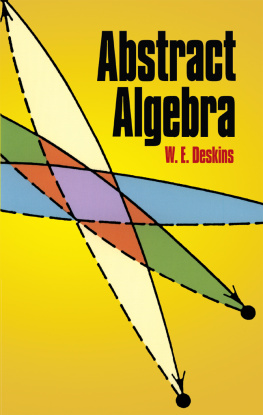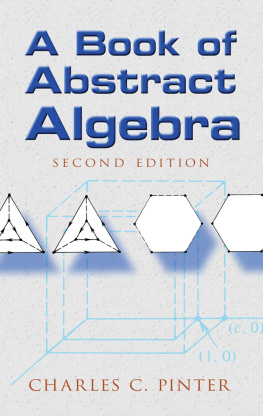BASIC
ABSTRACT
ALGEBRA
BASIC
ABSTRACT
ALGEBRA
For Graduate Students and
Advanced Undergraduates
Robert B. Ash
Department of Mathematics
University of Illinois
DOVER PUBLICATIONS, INC.
Mineola, New York
Copyright
Copyright 2000, 2007 by Robert B. Ash
All rights reserved.
Bibliographical Note
This Dover edition, first published in 2007, is the first publication in book form of the work originally titled Abstract Algebra: The Basic Graduate Year, which is available from the authors website: http://www.math.uiuc.edu/~r-ash/
This edition includes the introductory essay, Remarks on Expository Writing in Mathematics, which is available on the same site.
International Standard Book Number: 0-486-45356-1
Manufactured in the United States by Courier Corporation
45356103
www.doverpublications.com
TABLE OF CONTENTS
PREFACE
This is a text for the basic graduate sequence in abstract algebra, offered by most universities. We study fundamental algebraic structures, namely groups, rings, fields and modules, and maps between these structures. The techniques are used in many areas of mathematics, and there are applications to physics, engineering and computer science as well. In addition, I have attempted to communicate the intrinsic beauty of the subject. Ideally, the reasoning underlying each step of a proof should be completely clear, but the overall argument should be as brief as possible, allowing a sharp overview of the result. These two requirements are in opposition, and it is my job as expositor to try to resolve the conflict.
My primary goal is to help the reader learn the subject, and there are times when informal or intuitive reasoning leads to greater understanding than a formal proof. In the text, there are three types of informal arguments:
1. The concrete or numerical example with all features of the general case. Here, the example indicates how the proof should go, and the formalization amounts to substituting Greek letters for numbers. There is no essential loss of rigor in the informal version.
2. Brief informal surveys of large areas. There are two of these, p-adic numbers and group representation theory. References are given to books accessible to the beginning graduate student.
3. Intuitive arguments that replace lengthy formal proofs which do not reveal why a result is true. In this case, explicit references to a precise formalization are given. I am not saying that the formal proof should be avoided, just that the basic graduate year, where there are many pressing matters to cope with, may not be the appropriate place, especially when the result rather than the proof technique is used in applications.
I would estimate that about 90 percent of the text is written in conventional style, and I hope that the book will be used as a classroom text as well as a supplementary reference.
Solutions to all problems are included in the text; in my experience, most students find this to be a valuable feature. The writing style for the solutions is similar to that of the main text, and this allows for wider coverage as well as reinforcement of the basic ideas.
, the fundamental structure theorems for finitely generated modules over a principal ideal domain are developed concretely with the aid of the Smith normal form. Students will undoubtedly be comfortable with elementary row and column operations, and this will significantly aid the learning process.
In , the theme of groups acting on sets leads to a nice application to combinatorics as well as the fundamental Sylow theorems and some results on simple groups. Analysis of normal and subnormal series leads to the Jordan-Hlder theorem and to solvable and nilpotent groups. The final section, on defining a group by generators and relations, concentrates on practical cases where the structure of a group can be deduced from its presentation. Simplicity of the alternating groups and semidirect products are covered in the exercises.
. After some examples of direct calculation of a Galois group, we proceed to finite fields, which are of great importance in applications, and cyclotomic fields, which are fundamental in algebraic number theory. The Galois group of a cubic is treated in detail, and the quartic is covered in an appendix. Sections on cyclic and Kummer extensions are followed by Galois fundamental theorem on solvability by radicals. The last section of the chapter deals with transcendental extensions and transcendence bases.
In the remaining chapters, we begin to apply the results and methods of abstract algebra to related areas. The title of each chapter begins with Introducing , and the areas to be introduced are algebraic number theory, algebraic geometry, noncommutative algebra and homological algebra (including categories and functors).
Algebraic number theory and algebraic geometry are the two major areas that use the tools of commutative algebra (the theory of commutative rings). In , after an example showing how algebra can be applied in number theory, we assemble some algebraic equipment: integral extensions, norms, traces, discriminants, Noetherian and Artinian modules and rings. We then prove the fundamental theorem on unique factorization of ideals in a Dedekind domain. The chapter concludes with an informal introduction to p-adic numbers and some ideas from valuation theory.
begins geometrically with varieties in affine space. This provides motivation for Hilberts fundamental theorems, the basis theorem and the Nullstellensatz. Several equivalent versions of the Nullstellensatz are given, as well as some corollaries with geometric significance. Further geometric considerations lead to the useful algebraic techniques of localization and primary decomposition. The remainder of the chapter is concerned with the tensor product and its basic properties.
begins the study of noncommutative rings and their modules. The basic theory of simple and semisimple rings and modules, along with Schurs lemma and Jacobsons theorem, combine to yield Wedderburns theorem on the structure of semisimple rings. We indicate the precise connection between the two popular definitions of simple ring in the literature. After an informal introduction to group representations, Maschkes theorem on semisimplicity of modules over the group algebra is proved. The introduction of the Jacobson radical gives more insight into the structure of rings and modules. The chapter ends with the Hopkins-Levitzki theorem that an Artinian ring is Noetherian, and the useful lemma of Nakayama.
In , we introduce some of the tools of homological algebra. Waiting until the last chapter for this is a deliberate decision. Students need as much exposure as possible to specific algebraic systems before they can appreciate the broad viewpoint of category theory. Even experienced students may have difficulty absorbing the abstract definitions of kernel, cokernel, product, coproduct, direct and inverse limit. To aid the reader, functors are introduced via the familiar examples of hom and tensor. No attempt is made to work with general abelian categories. Instead, we stay within the category of modules and study projective, injective and flat modules.
In a supplement, we go much farther into homological algebra than is usual in the basic algebra sequence. We do this to help students cope with the massive formal machinery that makes it so difficult to gain a working knowledge of this area. We concentrate on the results that are most useful in applications: the long exact homology sequence and the properties of the derived functors Tor and Ext. There is a complete proof of the snake lemma, a rarity in the literature. In this case, going through a long formal proof is entirely appropriate, because doing so will help improve algebraic skills. The point is not to avoid difficulties, but to make most efficient use of the finite amount of time available.
Next page
